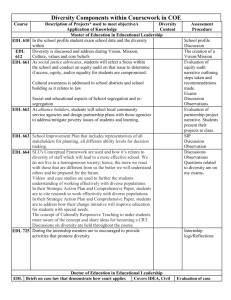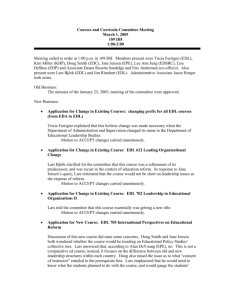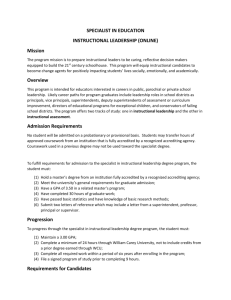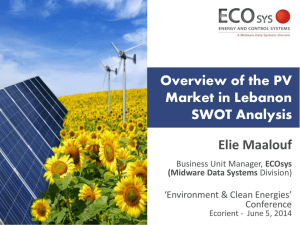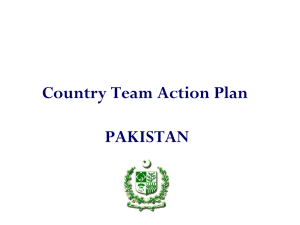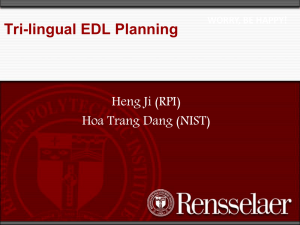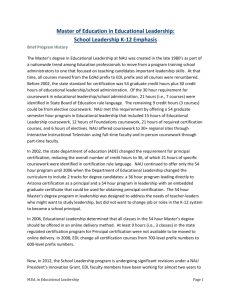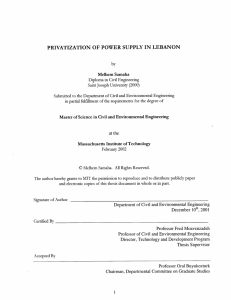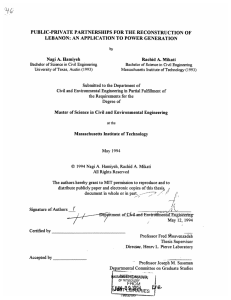Beirut and mount
advertisement
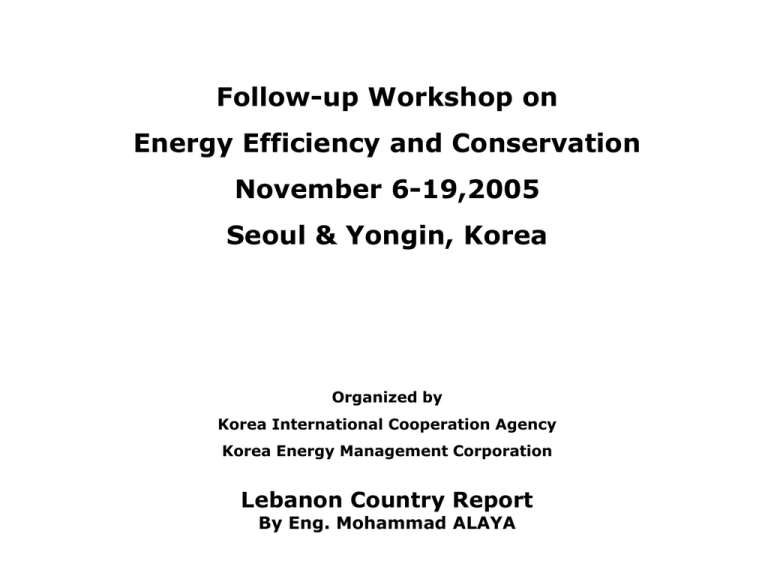
Follow-up Workshop on Energy Efficiency and Conservation November 6-19,2005 Seoul & Yongin, Korea Organized by Korea International Cooperation Agency Korea Energy Management Corporation Lebanon Country Report By Eng. Mohammad ALAYA Outline • EDL HISTORY • EDL ADMINISTRATIVE ORGANIZATION • EDL GENERATING UNITS • EDL TRANSMISSION NETWORK • EDL SUBSTATIONS • EDL DISTRIBUTION NETWORK • PRIVATIZATION PLANS EDL HISTORY • July 1954: The “Utility of Electricity an Common Transportation”: Established to manage the projects regained by the government from from “Beirut Electrical Company” • April 1961: A law separating the Common Transportation from the Electricity was issued: The Lebanese Electrical Utility EDL was established EDL ADMINISTRATIVE ORGANIZATION • Directorate of Generation • Directorate of Transmission • Directorate of Distribution in Beirut and Mount Lebanon • Directorate of Distribution in Bekaa, South and North Lebanon • Directorate of Equipment • Directorate of Studies • Directorate of Administrative Affairs • Directorate of Financial Affairs • Directorate of common Affairs • Auto Control Energy Current Situation • Electricity sector constitutes more than half of Energy sector in lebanon. • The electicity sector in Lebanon suffers from severe problems: • High level of non Technical losses. • Large number of unpaid bills. • The tremendous increase in the oil prices. EDL CURRENT SITUATION • EDL dominates 90% of the electricity sector • The remaining 10% is distributed between private hydraulic plants and hydraulic plants managed by the National Office of the Litani River • Distribution licenses are given to private companies in four different towns around Lebanon: Zahle, Jbeil, Aley, and Bhamdoun • Personnel Number: 3000 • A little more than One Million low tension subscribers . • Around 3000 Medium Tension subscribers •Unavailability of sufficient transmission and distribution infrastructure . • Israeli air strikes on different substations • Losses on the distribution network INSTALLED GENERTING UNITS • 1016 MW from EDL thermal units (Jieh, Hrayche, and Zouk) • 10 MW from EDL Hydraulic units (Richmaya) • 21.2 MW from Kadisha hydraulic units • 190 MW from Litani hydraulic units • 44.6 from other hydraulic units • 140 MW from EDL gas turbine (power plants Baalbek and Tyr) • 900 MW from EDL gas turbines (power plants Zahrani Beddawi) Total MW Installed: 2325 MW INSTALLED POWER PLANTS Thermal Power Plants in Lebanon Power Plants Installed MW Zouk 607 Hreicheh 70 Jieh 331 Deir Amar 435 Zahrani 435 Tyr 2*35 Baalbeck 2*35 Year Fuel Type 1984 Heavy Fuel 1983 Heavy Fuel 1972 Heavy Fuel 1997 gasoil/NG 1997 gasoil/NG 1996 Gas oil 1996 Gas oil Electricity Generation Production electrique au Liban 10000 million kWh 8000 Hydraulique 6000 Thermique 4000 Syrie 2000 0 1998 1999 2000 Hydraulique 786.1 331.3 448.9 330.67 677.92 1363.5 1121.6 Thermique 7570.2 7854.7 7390 7841.2 8982.4 9184.1 Syrie 653.8 1397 1271.3 531.65 846.3 2001 2002 2003 0 2004 9153 216.23 Thermal Generation in 2004 Production Thermique au Liban 1% 4% 1% 28% Zouk Jieh 26% Zahrani Deir Amar Baalbeck Hreicheh 16% 24% Tyr Switching To Natural Gas could be the solution Conversion to Natural Gas Lebanese Power Transmission Network Single Line Diagram of Transmission Network THE ACTUAL LEBANSE EPS DISTRIBUTION SYSTEM AND EDL ORGANISATION Two distribution administrations - Beirut and mount-Lebanon - Provinces The Lebanese regions are fully electrified 100%. The existing distribution network is at: 20, 15, 11, & 5.5 kV. The low voltage is 380 V The introduction of the private sector into electricity distribution is being planned Energy Sector Approach • The Energy Strategy should aim at satisfying & optimizing the supply/Demand balance of the various sectors of economy. • The energy sector encloses all forms of energies Energy Policy Objectives • Improvement of security &reliability of supply. • Economic efficiency of energy supply &use. • Reducing energy bill • Protection of environment. All this within the principles of sustainable development Principal Actors • • • • • ELectricite Du Liban Ministry of Energy and Water Ministry of Public Work &Transprtation Ministry of Environment Lebanese Norms Institute Particularities of the energy sector in Lebanon • Energy import dependency (98%).Mostly fossil fuels • Natural gas will be the main primary energy to the thermal electric generation and industry • Electric connection with Syria (to be extended) • Limited technologies for generation • Renewable energies still undeveloped Recent Developments • Issuance of a new Privatization law No 228/2000,the law 462/2002 to organize the electricity sector, the law 549 related to oil and gas projects… • Preparation and implementation of a power sector privatization strategy is in progress for privatization of generation and distribution activities • Negotiations are undergoing regarding implementation of the natural gas pipeline from Egypt. • Power interconnections with Egypt, Jordan, Syria to be completed in 2006. • Intention of outsourcing Operation and maintenance of the two CCPP(900 MW”) • Establishing the Lebanese Center for Energy Conservation and Planning Recent Developments A master plan to develop expansion planning and use of renewable energy resources to diversify energy supply is under preparation to meet Government policy objectives which aims at: • Improving the efficiency of operations to meet the energy needs of the country in an economic and environmentally sustainable manner. • Diversifying fuel mix and supply resources in the most costeffective way, while improving security of supply and introducing private sector participation. • Developing local energy resources including renewable energy to reduce the importation of energy. Recommendation Establish a head of agreement between the Lebanese side and the Korean side to profit from KEMKO long experience through the help and support of KOIKA. The cooperation could be implemented on different levels: • Training in Energy Audit. • Drafting Energy Efficiency Standards. • Promoting Escos(drafting requirements and implementing the procedures and mechanisms. • Dispatch Experts from KEMKO to assess the situation in Lebanon. • Implement a remote relation via internet to follow up effectively and at low cost the progress of the project

